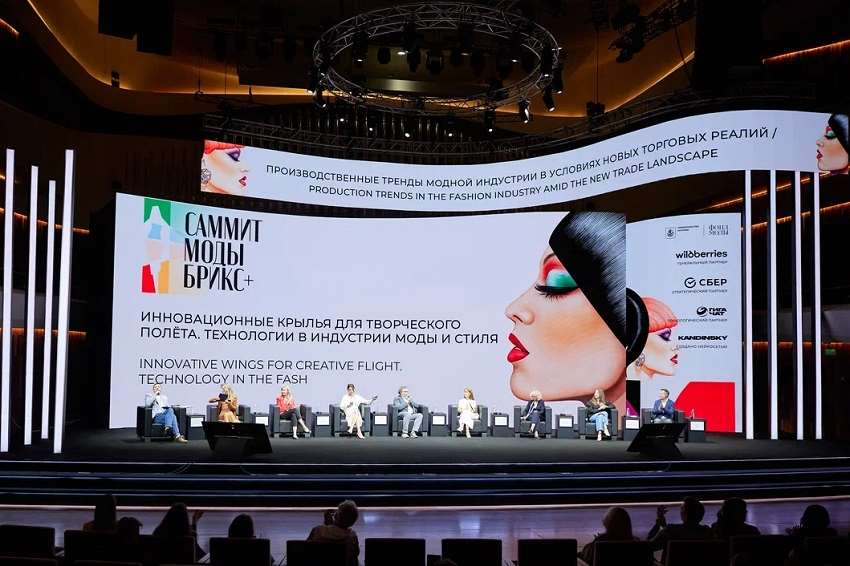The world's fashion landscape is undergoing a radical transformation, not just on the runway, but within the very fibers of its creation. This was the central theme of the inaugural BRICS+ Fashion Summit(August 28-30, 2025), held in conjunction with Moscow Fashion Week from August 31-September 2, 2025 . Experts from across the globe gathered to discuss a future where innovation isn't just a trend, but the essential warp and weft of the industry. The consensus was clear: technology is revolutionizing every aspect of fashion, from design and production to inclusivity and sustainability.
When technology becomes an accessory

The summit's opening day set the stage for a deep dive into the symbiotic relationship between creativity and code. In a session titled "Innovative Wings for Creative Flight," panelists explored how technology is no longer just a tool, but an integral part of the final product.
Veronika Levenets, Director of Endless Possibilities, offered a striking example of this fusion. “Technology itself can be a great accessory, a trend. For example, a bionic prosthesis combines functionality and design while attracting attention,” she said. Levenets spoke of her company’s creation of the world’s only prosthesis studded with six thousand Swarovski crystals, a bold statement designed to challenge perceptions. "Its true meaning emerges when a person wears it, integrates it into their image, style, and goes out into the world," she explained. "This is how a brand is born. When technology becomes part of culture, part of fashion, a single design can inspire not only an individual but an entire industry."
High-Tech Inclusivity: Beyond the niche

Technology is also paving the way for a more inclusive and accessible fashion world. In the "High-Tech Diversity" session, discussions centered on the adaptive fashion market, which is growing at a remarkable 12% annually. Experts highlighted the role of innovations like 3D body scanning, AI-driven personalization, and adaptive materials in creating clothing for people with special needs.
Veronika Levenets stressed that for inclusive fashion to move beyond a niche, the industry must embrace two key changes. “First, people with special needs must stop hiding, and the industry must start understanding their requests,” she said. “Second, designers should include people with special needs in fashion shows and adapt ready collections for them.”
Yelena Rusakova, Director of the Innovative Design Lab, pointed to the need for a more supportive ecosystem. "With government support, currently, only raincoats that fully cover wheelchair users, and maybe pants, can be produced," Rusakova noted. "We use new technologies, remote design systems, and digital twins. Since all this is innovation, funding is possible."
The Digital Frontier: Promise and peril

The digital transformation of fashion was a recurring theme, with experts debating the benefits and drawbacks. In a session on "Fashion Digitalization," speakers explored a future where virtual products and digital collections could account for a third of the premium segment’s revenue.
Anna Dreinberg, CEO of Tomorrow's Render Team, presented a forward-looking view of the industry. Her company specializes in immersive business projects using virtual reality, augmented reality, and metaverses. "We're developing Fashionverse 5.0 – a cyber-physical SaaS+On-Premise system for fashion brands," she explained, highlighting how technology is creating new business models.
However, not all participants shared this optimistic outlook. Elena Ermakovishna, Head of the Event Department at HSE Art and Design School, voiced a more cautionary perspective. "I view these technologies pessimistically because they consume enormous energy," she said. Ermakovishna advocated for a return to traditional craftsmanship, noting that while algorithms don't make mistakes, "interesting design solutions often emerge from errors."
This sentiment was echoed by Aleksandra Saukova, Head of the Fashion Design Workshop at Universal University, who highlighted a looming personnel crisis. "Everyone wants to be a designer, but no one considers who will execute that design," Saukova said. "Without a team of patternmakers, technologists, and tailors, designers cannot succeed. New technologies only produce results when you possess fundamental skills."
The Science of Style: Redefining materials

Beyond the digital realm, the summit also delved into the science of textiles and materials. In the "Textiles 2.0" session, experts from Russia, Indonesia, and other countries showcased how biotechnology and material science are creating a more sustainable and functional fashion future.
Anna Bikchurova, a fabrics and accessories specialist, cited the growing use of unconventional materials. "Fabrics from mushrooms, lotus, pineapple, and apples have already entered the international industry," she said. Bikchurova also pointed to breakthrough innovations like fabrics made from carbon dioxide, which "open breakthrough opportunities for reducing carbon footprints."
Galina Volkova, Owner of Orthomoda, discussed the fusion of health and style through technology. "Our goal is to combine health, comfort, and style," she stated, detailing her company’s creation of "smart shoes" using 3D scanning and printing, and adaptive footwear with sensors.
The discussions underscored a global movement to innovate while preserving heritage. Nuna Kusmayadi, from the Indonesian Fashion Chamber, provided a perfect example of this dual approach. “Our students work with traditional techniques like batik and weaving while learning digital tools, 3D design, and modern dyeing approaches," she said. "The younger generation must maintain cultural connections while embracing future technologies."
As the BRICS+ Fashion Summit concluded, it was clear that the future of fashion is a dynamic interplay of creativity and technology. It’s a future where a bionic prosthesis can be a fashion statement, where clothes are printed on demand to reduce waste, and where traditional craftsmanship is enhanced—not replaced—by digital tools. The message from Moscow was a powerful one: the industry is on the cusp of a new era, and its next chapter is being written in code, woven in smart fabrics, and inspired by a global, inclusive vision.












